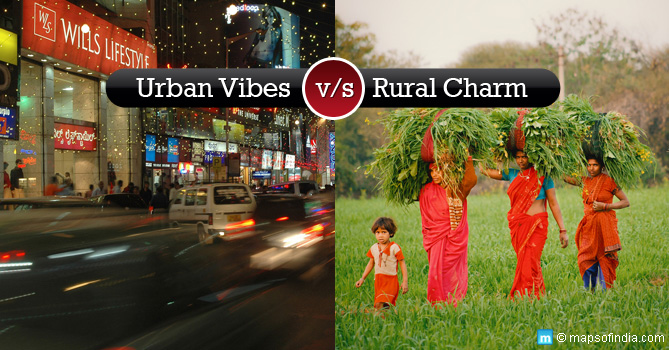In India, a region is considered to be a village or a rural area when the population density per square kilometre is 400, it has clear demarcated boundaries without a municipal board, and 75% of the working population is engaged in agriculture, or any of the cottage industries, fishing or pottery for a livelihood. In India approximately 72% of the population lives in the rural area, in approximately 50,000 villages.
Urban area in India, constituting cities and satellite cities, includes any region with a very high population density of more than 400 persons per square kilometre. It differs from a rural area in terms of infrastructure of built environment. It has more than 75% of its population engaged in non-agricultural activities. The 2011 census projects an accelerated urbanisation with more people migrating into urban areas in search of employment as well as education.
Life in a Village
There are approximately 50,000 villages in India. Far from the hustle and hustle of the cities, villages do have a charm of their own. In most of the villages, the view is scenic and the atmosphere tranquil. The air is pollution free and the environment peaceful. However, living in a village is full of trials and tribulations.
- Mostly everything done in villages is manual. Life is difficult and labour intensive.
- Most of the villages in India are very remote with some being literally inaccessible due to their locations on high altitudes.
- Life in a village is indeed very basic and the conditions primitive, with no infrastructure for water or electricity.
- Proper health care services are not available in villages, as a result of which many villagers suffer from conditions like malnutrition and diseases like tuberculosis. As per latest reports, 57 million children are malnourished in India, most of whom reside in villages.
- The practice of landlordship, where land is owned by a few rich people, has resulted in increase in the poverty in the villages, with the rich landlords getting richer by exploiting poor villagers.
- The caste system is still very much prevalent in villages adding on to the woes of the poor.
- Education available in villages lacks the infrastructure and good teachers because of which it is not of a good standard.
- Education takes a backseat with poverty taking over and thus in spite of laws against child labour, more and more children are sent away to work and earn a living for the family.
- The system of dividing the land among the sons during inheritance has resulted in making the plots smaller over a period of time till they are of no use on their own.
Life in a City
Urban life is a cake walk in comparison to life in a village. Be it infrastructure, facilities like water, electricity and sanitation, urban areas are well equipped and life in a city is more comfortable in spite of the growing pollution. A city life constitutes the following amenities:
- All kinds of facilities which make life more comfortable and easier are available in cities.
- Education is of good quality and thus more people from urban areas are better qualified, giving them the competitive edge to land the best jobs.
- The development in urban areas allows for more job opportunities and everyone gets paid for whatever effort they put in. When compared to the efforts of farmers being capitalised on landlords, city life is any day better.
- There is no caste system or discrimination and thus everyone stands an equal chance to do well in whatever field they opt for.
- Medical facilities are of excellent quality with some government run hospitals providing free treatment to people belonging to economically backward classes.
Migration
As per the 2011 census, more people are migrating to the cities with employment, education etc acting as a pull factor. There is migration from urban to rural areas too but the percentage is minuscule in comparison to the people moving from villages to cities. Mumbai saw the largest migration, and with a population of 12.5 million, it is at present the largest metropolis followed by Delhi (11 million) and a rise of 2% in population in Kolkata. Urbanisation commenced in India after independence, but in the recent years the trend has gained acceleration. The main causes for this trend are employment opportunities, education, medical facilities and chiefly, the promise of a better quality of life.
However, Indian cities are not equipped to cater to this accelerated speed of urbanisation and therefore, this trend is taking its toll on basic infrastructure like water supply, electricity lines and roads. As a result, not only is there an increase in slum areas and construction of unsafe and unauthorised buildings, there are issues of water and electricity shortage besides major environmental concerns to deal with, which is causing a deterioration in the urban standard of living.
Apart from the aforesaid problems, urbanisation is also creating havoc in other ways, such as disparity in the market, misuse of labour in the form of sweatshops, and last but not the least, the same urbanisation which began on the premise of availability of employment, is now causing a rise in unemployment and disguised employment, due to availability of excessive manpower.
It is important to understand that villages provide an equilibrium by balancing the agricultural requirements, maintaining the water table and controlling the pollution, and also act as a support system for counter balancing and maintaining the economic activities of the cities. It is thus important to encourage the rural population to stay where they are by improving the quality of life in the rural areas. The Indian government is also working on the same direction through schemes such as Pradhan Mantri Gram Sadak Yojana and Sansad Adarsh Gram Yojana.
Read More
10 Ways to Protect Children From Air Pollution






